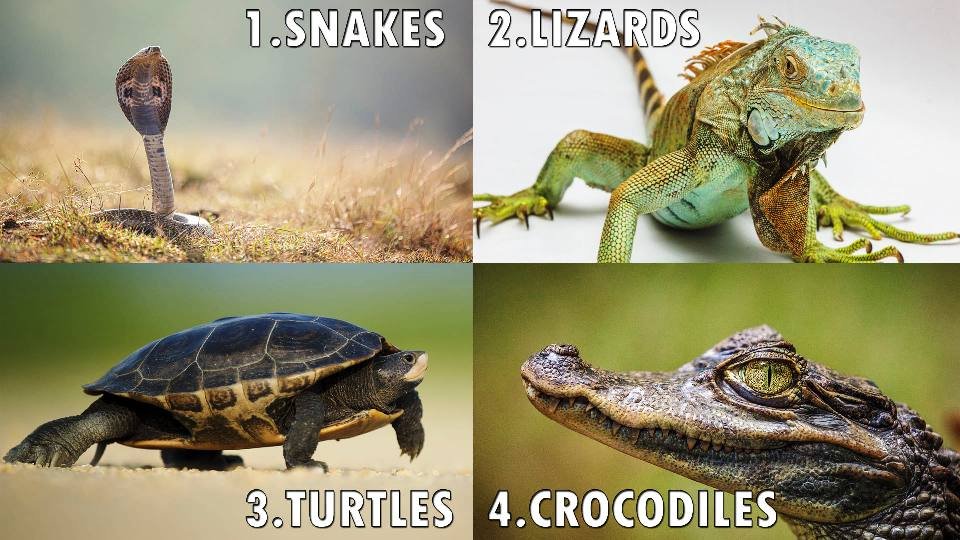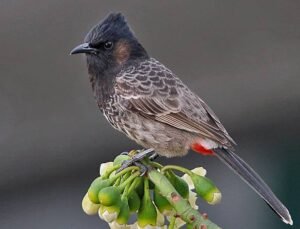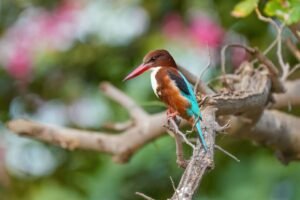What Are Reptiles?
Reptiles are a diverse group of cold-blooded vertebrates that include snakes, lizards, turtles, and crocodiles. Characterized by their scaly skin and egg-laying reproductive system, reptiles have adapted to a wide range of habitats, from deserts to rainforests. Unlike mammals and birds, reptiles rely on external sources of heat to regulate their body temperature, a trait known as ectothermy.

Types of Reptiles
Reptiles are classified into several categories based on their evolutionary characteristics. The main types are:
- Snakes (Serpentes): Legless reptiles with elongated bodies and a wide range of habitats.
- Lizards (Lacertilia): Typically with four legs, lizards have diverse species ranging from geckos to iguanas.
- Turtles and Tortoises (Testudines): Reptiles with a bony or cartilaginous shell that shields their body.
- Crocodiles and Alligators (Crocodylia): Large, aquatic reptiles known for their powerful jaws and semi-aquatic lifestyles.
The List Of Reptiles
| Category | Reptile | Scientific Name |
|---|---|---|
| Crocodilians | American Alligator | Alligator mississippiensis |
| Nile Crocodile | Crocodylus niloticus | |
| Saltwater Crocodile | Crocodylus porosus | |
| Gharial | Gavialis gangeticus | |
| Turtles and Tortoises | Green Sea Turtle | Chelonia mydas |
| Leatherback Sea Turtle | Dermochelys coriacea | |
| Desert Tortoise | Gopherus agassizii | |
| Galápagos Tortoise | Chelonoidis nigra | |
| Lizards | Komodo Dragon | Varanus komodoensis |
| Green Iguana | Iguana iguana | |
| Gila Monster | Heloderma suspectum | |
| Common Leopard Gecko | Eublepharis macularius | |
| Snakes | King Cobra | Ophiophagus hannah |
| Reticulated Python | Malayopython reticulatus | |
| Eastern Diamondback Rattlesnake | Crotalus adamanteus | |
| Black Mamba | Dendroaspis polylepis | |
| Amphisbaenians | Mole Worm Lizard | Amphisbaena alba |
| Mexican Worm Lizard | Bipes biporus | |
| Tuataras | Tuatara | Sphenodon punctatus |
Reptiles are an incredible group of animals with a wide range of adaptations and survival strategies. Here’s a closer look at various reptiles, their life cycles, and their lifespan, from birth to death.
1. Crocodilians
American Alligator (Alligator mississippiensis)
- Life Cycle: Female alligators build nests from vegetation and lay around 35-50 eggs. After hatching, the young stay with their mother for a few months. They grow rapidly in their first few years, reaching sexual maturity at around 6-10 years. In the wild, they can live up to 35-50 years, but in captivity, they might live longer.
- Survival: Young alligators face many threats from predators, including larger alligators. Adults have few natural predators, though they must contend with habitat loss and human activities.
Nile Crocodile (Crocodylus niloticus)
- Life Cycle: Females build nests and lay 20-60 eggs. Hatchlings are vulnerable and rely on the mother for protection. They mature sexually around 10-15 years. Nile crocodiles can live up to 70-100 years in the wild, and even longer in captivity.
- Survival: Nile crocodiles are apex predators with few natural enemies. Saltwater crocodiles are indeed impressive, but they’re not without their challenges. Their biggest threats come from habitat loss due to human development and illegal hunting.
Saltwater Crocodile (Crocodylus porosus)
- Life Cycle: Saltwater crocodiles lay eggs in sandy nests near water. After hatching, the young are highly vulnerable and need to avoid predators. They reach sexual maturity at around 10-15 years and can live up to 70-100 years.
- Survival: These crocodiles have few natural predators as adults. However, they face threats from habitat loss, human-wildlife conflict, and climate change.
Gharial (Gavialis gangeticus)
- Life Cycle: Gharials lay eggs in sandy riverbanks. Hatchlings are very small and vulnerable, and the mother provides some protection. They reach maturity at about 10-15 years. Gharials can live up to 35-50 years.
- Survival: Gharials are critically endangered due to habitat loss, pollution, and entanglement in fishing gear. Conservation efforts are ongoing to protect their remaining populations.
2. Turtles and Tortoises
Green Sea Turtle (Chelonia mydas)
- Life Cycle: Green sea turtles lay eggs on sandy beaches. Baby turtles face a tough and dangerous trek from their nest to the ocean. They grow slowly and reach maturity at about 20-30 years. They can live for 80 years or even longer.
- Survival: Hatchlings face high mortality rates due to predation and environmental hazards. Adults are threatened by habitat loss, climate change, and pollution.
Leatherback Sea Turtle (Dermochelys coriacea)
- Life Cycle: Leatherbacks lay eggs on tropical beaches. Hatchlings head straight for the ocean. They grow rapidly and reach maturity around 15-20 years. Leatherbacks can live up to 50 years.
- Survival: Leatherbacks face numerous threats, including bycatch in fishing gear, habitat loss, and climate change. They are listed as vulnerable.
Desert Tortoise (Gopherus agassizii)
- Life Cycle: Female desert tortoises lay eggs in burrows. Hatchlings are independent and face a tough desert environment. They mature around 15-20 years and can live over 50 years.
- Survival: Desert tortoises are adapted to arid environments but are threatened by habitat destruction and disease.
Galápagos Tortoise (Chelonoidis nigra)
- Life Cycle: Galápagos tortoises lay eggs in nests on the ground. Hatchlings face predation and harsh conditions. They reach sexual maturity around 20-30 years and can live over 100 years.
- Survival: They have few natural predators but are threatened by habitat loss, introduced species, and human activities.
3. Lizards
Komodo Dragon (Varanus komodoensis)
- Life Cycle: Female Komodo dragons lay eggs in burrows. Hatchlings are vulnerable and spend their early years in trees to avoid predators. They reach maturity around 8-10 years and can live up to 30 years.
- Survival: Komodo dragons are apex predators on their islands, but they face threats from habitat loss and human encroachment.
Green Iguana (Iguana iguana)
- Life Cycle: Green iguanas lay eggs in nests dug in the ground. Hatchlings are on their own right from the start and have to look after themselves. They reach maturity around 2-4 years and can live up to 20 years.
- Survival: They face threats from habitat loss and the pet trade. In some areas, they are also considered invasive species.
Gila Monster (Heloderma suspectum)
- Life Cycle: Female Gila monsters lay eggs in burrows. Hatchlings are independent and must find food and shelter. They reach maturity around 5-7 years and can live up to 20-30 years.
- Survival: Gila monsters are venomous and face few predators, but they are threatened by habitat destruction.
Common Leopard Gecko (Eublepharis macularius)
- Life Cycle: Female leopard geckos lay eggs in burrows. Hatchlings are independent and grow rapidly. They reach maturity around 1-2 years and can live up to 15-20 years.
- Survival: Common leopard geckos are popular pets, and in the wild, they face threats from habitat loss and predators.
4. Snakes
King Cobra (Ophiophagus hannah)
- Life Cycle: King cobras lay eggs in a nest, which the female guards. Hatchlings are independent and face many dangers. They reach maturity at around 4-5 years and can live up to 20 years.
- Survival: King cobras are top predators with few natural enemies. They face threats from habitat destruction and human-wildlife conflict.
Reticulated Python (Malayopython reticulatus)
- Life Cycle: Female reticulated pythons lay eggs in a clutch, which they incubate. Hatchlings are independent and grow quickly. They reach maturity around 3-4 years and can live up to 20-25 years.
- Survival: They are powerful constrictors but face threats from habitat loss and the pet trade.
Eastern Diamondback Rattlesnake (Crotalus adamanteus)
- Life Cycle: Females give birth to live young, which are independent at birth. They reach maturity around 3-4 years and can live up to 20 years.
- Survival: Eastern diamondbacks face threats from habitat loss and persecution. The rattle on their tail acts as a warning signal to any potential threats.
Black Mamba (Dendroaspis polylepis)
- Life Cycle: Black mambas lay eggs in a nest. Hatchlings are independent and face numerous threats. They reach maturity around 2-3 years and can live up to 11 years.
- Survival: Known for their speed and venom, black mambas face threats from habitat destruction and human conflict.
5. Amphisbaenians
Mole Worm Lizard (Amphisbaena alba)
- Life Cycle: Mole worm lizards lay eggs in burrows. Hatchlings are independent and face a subterranean lifestyle. They reach maturity around 2-3 years and can live up to 10-15 years.
- Survival: Adapted to a burrowing lifestyle, they face threats from habitat destruction and environmental changes.
Mexican Worm Lizard (Bipes biporus)
- Life Cycle: Mexican worm lizards lay eggs in soil. Hatchlings are independent and burrow into the ground. They reach maturity around 2-3 years and can live up to 10-12 years.
- Survival: They are adapted to a subterranean lifestyle and face threats from habitat loss.
6. Tuataras
Tuatara (Sphenodon punctatus)
- Life Cycle: Tuataras lay eggs in burrows. Hatchlings are independent and face a slow growth rate. They reach sexual maturity around 10-20 years and can live over 100 years.
- Survival: Tuataras have few natural predators but are threatened by habitat destruction and introduced species. They are considered living fossils with a unique evolutionary lineage.
YOU CAN ALSO LIKE
| TITLE | Link |
|---|---|
| Nag Panchami 2024 | Nag Panchami 2024 |
| Nag Panchami 2024 (Wildlife Nest) | Nag Panchami 2024 |
| The Deadliest Venom | The Deadliest Venom |
| Most Dangerous Snakes in the World | Most Dangerous Snakes in the World |
| The Ultimate Guide to Snakes | The Ultimate Guide to Snakes |
| History of Snakes: Evolution, Habitats, and Survival | History of Snakes |
FAQs About Reptiles
1. What exactly are reptiles?
Reptiles are cold-blooded vertebrates that include animals like snakes, lizards, turtles, and crocodiles. They have scaly skin and most lay eggs, though some give live birth. Unlike mammals, reptiles rely on external sources like the sun to regulate their body temperature.
2. How are reptiles different from amphibians?
Reptiles have scaly, dry skin, while amphibians have moist, smooth skin. Reptiles lay eggs with tough shells, usually on land, whereas amphibians lay soft eggs in water. Additionally, reptiles breathe through lungs at all stages of life, while amphibians often start with gills and develop lungs later.
3. Are all reptiles dangerous?
Not all reptiles are dangerous. While some, like venomous snakes or large crocodiles, can be harmful to humans, many reptiles are harmless and even beneficial to ecosystems by controlling pest populations.
4. How long do reptiles typically live?
Reptile lifespans vary widely depending on the species. Turtles and tortoises can live for over 100 years, while some snakes and lizards may only live for 10-20 years. In general, reptiles tend to have longer lifespans than many other animals.
5. Do reptiles make good pets?
Some reptiles, like leopard geckos, corn snakes, and certain tortoises, can make good pets for those willing to meet their specific needs. However, reptiles require proper care, including specific temperature and humidity levels, so they’re best suited for dedicated owners.
6. Why are reptiles cold-blooded?
Reptiles are cold-blooded creatures, which means they depend on outside heat sources, like the sun, to keep warm. This ability to adjust their activity based on the temperature around them helps reptiles thrive in many different environments, from scorching deserts to cool forests.
7. How do reptiles reproduce?
Most reptiles reproduce by laying eggs, but some, like certain species of snakes and lizards, give live birth. Reptile eggs typically have leathery shells and are laid in protected environments like burrows or nests.
8. What should I do if I encounter a wild reptile?
If you come across a wild reptile, it’s best to observe it from a safe distance and avoid touching or provoking it. Many reptiles are shy and will move away if not disturbed. If you’re in an area where venomous snakes or large reptiles are common, stay alert and aware of your surroundings.
9. Are there any endangered reptiles?
Yes, many reptile species are endangered due to habitat loss, climate change, poaching, and the illegal pet trade. Species like the gharial, green sea turtle, and tuatara are under threat and require conservation efforts to ensure their survival.
10. What role do reptiles play in the ecosystem?
Reptiles are crucial to ecosystems as both predators and prey. They help control pest populations, spread seeds, and provide food for other animals. Some, like sea turtles, play a key role in maintaining the health of marine environments.
11. How do reptiles defend themselves?
Reptiles have various defense mechanisms. Some use camouflage to blend in with their surroundings, while others might hiss, bite, or even play dead to avoid predators. Venomous reptiles like certain snakes use their venom as a potent defense and hunting tool.
12. Can reptiles regenerate body parts?
Certain reptiles, like some lizards, can regenerate lost body parts such as tails. This ability helps them escape predators, but the regenerated tail is often not as strong or functional as the original.


